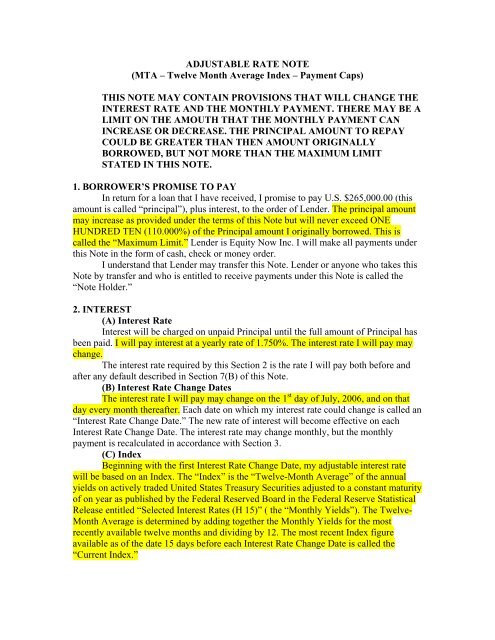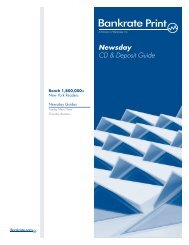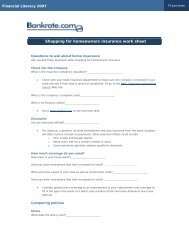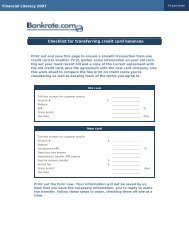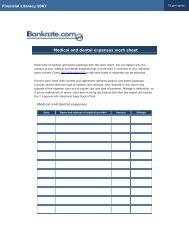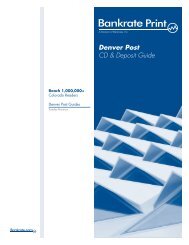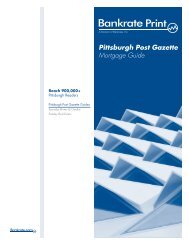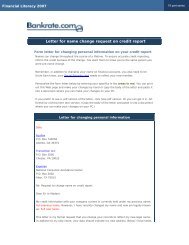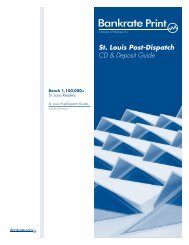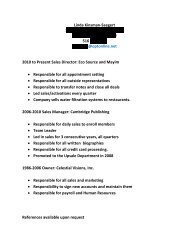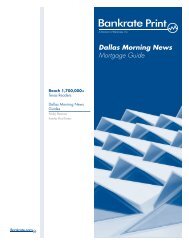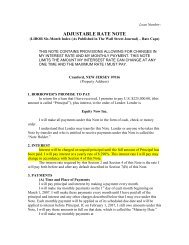ADJUSTABLE RATE NOTE (MTA – Twelve Month Average Index ...
ADJUSTABLE RATE NOTE (MTA – Twelve Month Average Index ...
ADJUSTABLE RATE NOTE (MTA – Twelve Month Average Index ...
You also want an ePaper? Increase the reach of your titles
YUMPU automatically turns print PDFs into web optimized ePapers that Google loves.
<strong>ADJUSTABLE</strong> <strong>RATE</strong> <strong>NOTE</strong><br />
(<strong>MTA</strong> <strong>–</strong> <strong>Twelve</strong> <strong>Month</strong> <strong>Average</strong> <strong>Index</strong> <strong>–</strong> Payment Caps)<br />
THIS <strong>NOTE</strong> MAY CONTAIN PROVISIONS THAT WILL CHANGE THE<br />
INTEREST <strong>RATE</strong> AND THE MONTHLY PAYMENT. THERE MAY BE A<br />
LIMIT ON THE AMOUTH THAT THE MONTHLY PAYMENT CAN<br />
INCREASE OR DECREASE. THE PRINCIPAL AMOUNT TO REPAY<br />
COULD BE GREATER THAN THEN AMOUNT ORIGINALLY<br />
BORROWED, BUT NOT MORE THAN THE MAXIMUM LIMIT<br />
STATED IN THIS <strong>NOTE</strong>.<br />
1. BORROWER’S PROMISE TO PAY<br />
In return for a loan that I have received, I promise to pay U.S. $265,000.00 (this<br />
amount is called “principal”), plus interest, to the order of Lender. The principal amount<br />
may increase as provided under the terms of this Note but will never exceed ONE<br />
HUNDRED TEN (110.000%) of the Principal amount I originally borrowed. This is<br />
called the “Maximum Limit.” Lender is Equity Now Inc. I will make all payments under<br />
this Note in the form of cash, check or money order.<br />
I understand that Lender may transfer this Note. Lender or anyone who takes this<br />
Note by transfer and who is entitled to receive payments under this Note is called the<br />
“Note Holder.”<br />
2. INTEREST<br />
(A) Interest Rate<br />
Interest will be charged on unpaid Principal until the full amount of Principal has<br />
been paid. I will pay interest at a yearly rate of 1.750%. The interest rate I will pay may<br />
change.<br />
The interest rate required by this Section 2 is the rate I will pay both before and<br />
after any default described in Section 7(B) of this Note.<br />
(B) Interest Rate Change Dates<br />
The interest rate I will pay may change on the 1 st day of July, 2006, and on that<br />
day every month thereafter. Each date on which my interest rate could change is called an<br />
“Interest Rate Change Date.” The new rate of interest will become effective on each<br />
Interest Rate Change Date. The interest rate may change monthly, but the monthly<br />
payment is recalculated in accordance with Section 3.<br />
(C) <strong>Index</strong><br />
Beginning with the first Interest Rate Change Date, my adjustable interest rate<br />
will be based on an <strong>Index</strong>. The “<strong>Index</strong>” is the “<strong>Twelve</strong>-<strong>Month</strong> <strong>Average</strong>” of the annual<br />
yields on actively traded United States Treasury Securities adjusted to a constant maturity<br />
of on year as published by the Federal Reserved Board in the Federal Reserve Statistical<br />
Release entitled “Selected Interest Rates (H 15)” ( the “<strong>Month</strong>ly Yields”). The <strong>Twelve</strong>-<br />
<strong>Month</strong> <strong>Average</strong> is determined by adding together the <strong>Month</strong>ly Yields for the most<br />
recently available twelve months and dividing by 12. The most recent <strong>Index</strong> figure<br />
available as of the date 15 days before each Interest Rate Change Date is called the<br />
“Current <strong>Index</strong>.”
If the <strong>Index</strong> is no longer available, the Note Holder will choose a new index that<br />
is based upon comparable information. The Note Holder will give me notice of this<br />
choice.<br />
(D) Calculation of Interest Rate Changes<br />
Before each Interest Rate Change Date, the Note Holder will calculate my new<br />
interest rate by adding THREE AND THREE TWENTIETHS percentage point(s)<br />
3.150% (“Margin”) to the Current <strong>Index</strong>. The Note Holder will then round the results of<br />
this addition to the nearest one-eighth of one percentage point (0.125%). This rounded<br />
amount will be my new interest rate until the next Interest Rate Change Date.<br />
3. PAYMENTS<br />
(A) Time and Place of Payments<br />
I will make a payment every month.<br />
I will make my monthly payments on the 1 st day of each month beginning on July<br />
1, 2006. I will make these payments every month until I have paid all the Principal and<br />
Interest and any other changes described below that I may owe under this Note. Each<br />
monthly payment will be applied as of its scheduled due date and will be applied to<br />
interest before Principal. If, on June 1, 2036, I still owe amounts under the Note, I will<br />
pay those amounts in full on that date, which is called the “Maturity Date.”<br />
I will make my monthly payments at<br />
Equity Now Inc.<br />
1370 Avenue of the Americas<br />
New York, NEW YORK 10018<br />
or at a different place if required by the Note Holder.<br />
(B) Amount of My Initial <strong>Month</strong>ly Payments<br />
Each of my initial monthly payments until the first Payment Change Date will be<br />
in the amount of U.S. $946.70 unless adjusted under Section 3(F).<br />
(C) Payment Change Date<br />
My monthly payment may change as required by Section 3(D) below beginning<br />
on the 1 st day of July, 2006, and on that day every 12 th month thereafter. Each of these<br />
dates is called a “Payment Change Date.” My monthly payment also will change at any<br />
time Section 3(F) or 3(G) requires me to pay a different monthly payment. The<br />
“Minimum Payment” is the minimum amount the Note Holder will accept for my<br />
monthly payment which is determined at the last Payment Change Date or as provided by<br />
Section 3(F) or 3(G) below if the Minimum Payment is not sufficient to cover the amount<br />
of the interest due then negative amortization will occur.<br />
I will pay the amount of my new Minimum Payment each month beginning on<br />
each Payment Change Date or as provided in Section 3(F) or 3(G) below.<br />
(D) Calculation of <strong>Month</strong>ly Payment Changes<br />
At least 30 days before each Payment Change Date, the Note Holder will<br />
calculate the amount of the monthly payment that would be sufficient to repay the unpaid<br />
Principal that I am expected to owe at the Payment Change Date in full on the maturity
date in substantially equal payments at the interest rate effective during the month<br />
preceding the Payment Change Date. The result of this calculation is called the “Full<br />
Payment.” Unless Section 3(F) or 3(G) apply, the amount of my new monthly payment<br />
effective on a Payment Change Date, will not increase by more than7.500% of my prior<br />
monthly payment. This 7500% limitation is called the “Payment Cap.” This Payment Cap<br />
applies only to the Principal and Interest payment and does not apply to any escrow<br />
payments Lender may require under the Security Instrument. The Not Holder will apply<br />
the Payment Cap by taking the amount of my Minimum Payment due the month<br />
preceding the Payment Change Date and multiplying it by the number 1.075. The result<br />
of this calculation is called the “Limited Payment.” Unless Section 3(F) or 3(G) below<br />
requires me to pay a different amount, my new Minimum Payment will be the lesser of<br />
the Limited Payment and the Full Payment. I also have the option to pay the Full<br />
Payment for my monthly payment.<br />
(E) Additions to My Unpaid Principal<br />
Since my monthly payment amount changes less frequently than the interest rate,<br />
and since the monthly payment is subject to the payment limitations described in Section<br />
3(D), my Minimum Payment could be less than or greater than the amount of the interest<br />
portion of the monthly payment that would be sufficient to repay the unpaid Principal I<br />
owe the monthly payment date in full on the Maturity Date in substantially equal<br />
payments. For each month that my monthly payment is less than the interest portion, the<br />
Note Holder will subtract the amount of my monthly payment form the amount of the<br />
interest portion and will add the difference to my unpaid Principal, and interest will<br />
accrue on the amount of this difference at the interest rate required by Section 2. For each<br />
month that the monthly payment is greater than the interest portion, the Note Holder will<br />
apply the payment as provided in Section 3(A).<br />
(F) Limit on My Unpaid Principal; Increased <strong>Month</strong>ly Payment<br />
My unpaid Principal can never exceed the Maximum Limit equal to ONE<br />
HUNDRED TEN percent (110%) of the Principal amount I originally borrowed. My<br />
unpaid Principal could exceed that Maximum Limit du to Minimum Payments and<br />
interest rate increases. In that event, on the date that my paying my monthly payment<br />
would cause me to exceed that limit, I will instead pay a new monthly payment. This<br />
means that my monthly payment may change more frequently than annually and such<br />
payment changes will not be limited by the 7.500% Payment Cap. The new Minimum<br />
Payment will be in an amount that would be sufficient to repay my then unpaid Principal<br />
in full on the Maturity Date in substantially equal payments at the current interest rate.<br />
(G) Required Full Payment<br />
On the FIFTH Payment Change Date and on each succeeding FIFTH Payment<br />
Change Date thereafter, I will begin paying the Full Payment as my Minimum Payment<br />
until my monthly payment changes again. I also will begin paying the Full Payment as<br />
my Minimum Payment on the final Payment Change Date.<br />
(H) Payment Options<br />
After the first Interest Rate Change Date, Lender may provide me with up to three<br />
(3) additional payment options that are greater than the Minimum Payment which are<br />
called “Payment Options.” I may be given the following Payment Options:<br />
(i) Interest Only Payment: the amount that would pay the interest portion of the<br />
monthly payment at the current interest rate. The Principal balance will not be
decreased by this Payment Option and it is only available if the interest portion<br />
exceeds the Minimum Payment.<br />
(ii) Fully Amortized Payment: the amount necessary to pay the loan off<br />
(Principal and Interest) at the Maturity Date in substantially equal payments.<br />
(iii) 15 Year Amortized Payment: the amount necessary to pay the loan off<br />
(Principal and Interest) within a fifteen (15) year term from the first payment due<br />
date in substantially equal payments. This monthly payment amount is calculated<br />
on the assumption that the current rate will remain in effect for the remaining<br />
term.<br />
These payments Options are only applicable if they are greater than the Minimum<br />
Payment.<br />
4. NOTICE OF CHANGES<br />
The Note Holder will deliver of mail to me a notice of any changes in the amount<br />
of my monthly payment before the effective date of any change. The notice will include<br />
information required by law to be given to me and also the title and telephone number of<br />
a person who will answer any questions I may have regarding the notice.<br />
Loan Number Min<br />
5. BORROWER’S RIGHT TO REPAY<br />
I have the right to make payments of Principal at any time before they are due. A<br />
payment of Principal only is known as a “Prepayment.” When I make a Prepayment, I<br />
will tell the Note Holder in writing that I am doing so. I may not designate a payments as<br />
a Prepayment if I have not made all the monthly payments due under the Note.<br />
I may make a full Prepayment or partial Prepayments without paying any<br />
Prepayment charge. The Note Holder will use my Prepayments to reduce the amount of<br />
Principal that I owe under this Note. If I make a partial Prepayment, there will be no<br />
changes in the due dates of my monthly payments. My partial Prepayment may reduce<br />
the amount if my monthly payments after the first Payment Change Date following my<br />
partial Prepayment. However, any reduction due to my partial Prepayment may be offset<br />
by an interest rate increase.<br />
6. LOAN CHARGES<br />
If a law, which applies to this loan and which sets maximum loan charges, is<br />
finally interpreted so that the interest or other loan charges collected or to be collected in<br />
connection with this loan exceed the permitted limits, then: (a) any such loan charge shall<br />
be reduced by the amount necessary to reduce the charge to the permitted limit; and (b)<br />
any sums already connected from me that exceeded permitted limits will be refunded to<br />
me. The Note Holder may choose to make this refund by reducing the Principal I owe<br />
under this Note or by making a direct payment to me. If a refund reduces Principal, the<br />
reduction will be treated as a partial Prepayment.<br />
7. BORROWER’S FAILURE TO PAY AS REQUIRED<br />
(A) Late Charges for Overdue Payments<br />
If the Note Holder has not received the full amount of any monthly payment by<br />
the end of the FIFTEEN (15) calendar days after the date it is due, I will pay a late
charge to the Note Holder. The amount of the charge will be 2.000% of my overdue<br />
payment of Principal and Interest. I will pay this late charge promptly but only once on<br />
each late payment.<br />
(B) Default<br />
If I do not pay the full amount of each monthly payment on the date it is due, I<br />
will be in default.<br />
(C) Notice of Default<br />
If I am in default, the Note Holder may send me a written notice telling me that if<br />
I do not pay the overdue amount by a certain date, the Note Holder may require me to<br />
pay immediately the full amount of Principal that has not been paid and all the interest<br />
that I owe on that amount. That date must be at least 30 days after the date on which the<br />
notice is mailed to me or delivered by other means.<br />
(D) No waiver by Note Holder<br />
Even if, at a time when I am in default, the Note Holder does not require me to<br />
pay immediately in full as described above, the Note Holder will still have the right to do<br />
so if I am in default at a later time.<br />
(E) Payment of Note Hoder’s Costs and Expenses<br />
If the Note Holder has required me to pay immediately in full as described above,<br />
the Note Holder will have the right to be paid back by me for all of its costs and expenses<br />
in enforcing this note to the extent not prohibited by applicable law. These expenses<br />
include, for example, reasonable attorneys’ fees.<br />
8. GIVING OF NOTICES<br />
Unless applicable law requires a different method, any notice that must be given<br />
to me under this Note will be given by delivering it or by mailing it by first class mail to<br />
me at the Property Address above or at a different address stated in Section 3(A) above or<br />
at a different address if I am given a notice of that different address.<br />
9. OBLIGATIONS OF PERSONS UNDER THIS <strong>NOTE</strong><br />
If more than person signs this Note, each person is fully and personally obligated<br />
to keep all the promises made in this Note, including the promise to pay the full amount<br />
owed. Any person who is a guarantor, surety or endorser of this Note is also obligated to<br />
do these things. Any person who takes over these obligations, including the obligations of<br />
a guarantor, surety or endorser of this Note, is also obligated to keep all the promises<br />
made in this Note. The Note Holder may enforce its rights under this Note against each<br />
person individually or against all of us together. This means that any one of us may be<br />
required to pay all of the amounts owed under this Note.<br />
10. WAIVERS<br />
I and any other person who has obligations under this Note waive the rights of<br />
Presentment and Notice of Dishonor. “Presentment” means the right to require the Note<br />
Holder to demand payment of amounts due. “Notice of Dishonor” means the right to<br />
require the Note Holder to give notice to other persons that amounts due have not been<br />
paid.<br />
11. SECURED <strong>NOTE</strong>
In addition to the protections given to the Note Holder under this Note, a<br />
Mortgage, Deed of Trust, or Security Deed (the “Security Instrument”), dated the same<br />
date as this Note, protects the Note Holder from possible losses that might result if I do<br />
not keep that promises that I make in this Note. That Security Instrument describes how<br />
and under what conditions I may be required to make immediate payment in full of all<br />
amounts I owe under this Note. Some of these conditions are described as follows:<br />
Transfer of the Property or a Beneficial Interest in Borrower. As used<br />
in this Section 18, “Interest in the Property” means any legal or<br />
beneficiary interest in the Property, including, but not limited to, those<br />
beneficial interests transferred in a bond for deed, contract for deed,<br />
installment sales contract or escrow agreement, the intent of which is the<br />
transfer of title by Borrowed at a future date to a purchaser.<br />
If all or any part of the Property or any Interest in the Property is sold or<br />
transferred (or if Borrower is not a natural person and a beneficial interest<br />
in Borrower is sold or transferred) without Lender’s prior written consent,<br />
Lender may require immediate payment in full of all sums secured by this<br />
Security Instrument. However, this option shall not be exercised by<br />
Lender if such exercise is prohibited by Applicable Law. Lender also shall<br />
not exercise this option if: (a) Borrower causes to be submitted to Lender<br />
information required by Lender to evaluate the intended transferee as if a<br />
new loan were being made to the transferee; and (b) Lender reasonably<br />
determines that Lender’s security will not be impaired by the loan<br />
assumption and that the risk of a breach of any covenant or agreement in<br />
this Security Instrument is acceptable to the lender.<br />
To the extent permitted by Applicable Law, Lender may charge a<br />
reasonable fee as a condition to Lender’s consent to the loan assumption.<br />
Lender may also require the transferee to sign an assumption agreement<br />
that is acceptable to Lender and that obligates the transferee to keep all the<br />
promises and agreements made in the Note and in this Security<br />
Instrument. Borrower will continue to be obligated under the Note and this<br />
Security Instrument unless Lender releases Borrower in writing.<br />
If Lender exercises the option to require immediate payment in full,<br />
Lender shall give Borrower notice of acceleration. The notice shall<br />
provide a period of not less than 30 days from the date the notice is given<br />
in accordance with Section 15 within which Borrower must pay all sums<br />
secured by this Security Instrument. If Borrower fails to pay these sums<br />
prior to the expiration of this period, Lender may invoke any remedies<br />
permitted in this Security Instrument without further demand on Borrower.<br />
WITNESS THE HAND(S) AND SEAL(S) OF THE UNDERSIGNED
________________________ _(Seal) _______________________(Seal)<br />
-Borrower -Borrower<br />
Social Security number:<br />
(sign original only)<br />
• Maximum limit<br />
This is an indication that the loan allows "negative amortization." In other words,<br />
the borrower may make monthly payments that don't even cover the interest<br />
charges. The difference is added to the loan amount. This passage says the<br />
negative amortization can't exceed 10 percent. The loan is for $265,000, so<br />
negative amortization can't top $26,500. It's possible for the loan balance to rise to<br />
$291,500, but no higher.<br />
• Teaser rate<br />
Good news! The interest rate is only 1.75 percent! Bad news: "The interest rate I<br />
will pay may change." That indicates that this is an adjustable-rate mortgage. That<br />
starting interest rate is often called a "teaser rate" or "introductory rate."<br />
• Rate change dates<br />
Even worse news: The teaser rate lasts only a month! This loan closed on May 25,<br />
2006, the first monthly payment was due July 1, 2006 -- and that's when the<br />
interest rate changes for the first time, too. Then the rate changes every month.<br />
(But the payment doesn't necessarily change. More on that later.)<br />
• <strong>Index</strong><br />
Each month's interest rate is calculated by adding an index to a margin. An index<br />
is an interest rate or bond yield paid on some other type of debt, such as U.S.<br />
Treasury notes, an average of savings-account rates paid in the Western states or<br />
rates that banks charge one another in wholesale money markets in London. This<br />
passage tells you which index the loan uses -- the 12-month average of constantmaturity<br />
1-year Treasury notes, widely known as the 12-month <strong>MTA</strong>. Although<br />
this description doesn't use the phrase "12-month <strong>MTA</strong>," the heading at the top of<br />
the first page reads "<strong>MTA</strong> - <strong>Twelve</strong> <strong>Month</strong> <strong>Average</strong> <strong>Index</strong>," and the footer at the<br />
bottom of each page reads "<strong>MTA</strong> <strong>Index</strong>." This loan's index is the 12-month <strong>MTA</strong><br />
yield 15 days before the first of the month.<br />
• Margin<br />
Each month, when the reset date rolls around, the new rate is calculated by adding<br />
a margin to the index. The index is the 12-month <strong>MTA</strong>; the margin, as described<br />
in this passage, is 3.15 percent. Let's say the index is 5 percent. Add the margin to<br />
that and you get 8.15 percent. In virtually all cases, the 12-month <strong>MTA</strong> won't be a<br />
round number like that. Let's say it's 5.029 percent. Add the margin of 3.15<br />
percent to that, and you get 8.179 percent. Then the lender rounds it, up or down,<br />
to the nearest 0.125 percent. In this case, the lender would round down to 8.125<br />
percent.<br />
• Rate cap<br />
An adjustable-rate mortgage's interest rate is based upon an index plus a margin,
ut that's not all that determines the new rate. This option ARM has limits, called<br />
"caps," that restrict the maximum and minimum interest rates. Note that the word<br />
"cap" doesn't appear in this description of the caps. This passage describes two<br />
caps. The maximum possible rate is 9.95 percent. The minimum possible rate is<br />
the margin -- 3.15 percent. In practice, the rate charged after the first rate change<br />
was much higher than that. In mid-June 2006, the 12-month <strong>MTA</strong> was around 4.5<br />
percent. The margin was 3.15 percent. So the rate jumped from 1.75 percent in the<br />
first month to around 7.625 percent in the second month. At least it can't rise<br />
above 9.95 percent. (Since the rate has to be rounded to the nearest eighth of a<br />
percent, the maximum rate is really 9.875 percent.)<br />
• Payment amounts<br />
The minimum monthly payment is $946.70 unless negative amortization increases<br />
to the maximum limit. Then it will rise according to the rules in Section 3(F).<br />
• Payment change dates<br />
The minimum monthly payment may change every July, and then it lasts a year<br />
except in certain cases described in confusing detail below. Note the mention of<br />
negative amortization.<br />
• Calculating monthly payments<br />
The minimum monthly payment can't increase more than 7.5 percent when it is<br />
changed each July. This payment cap applies to increases in principal and interest<br />
and doesn't count taxes, insurance and other fees added to the monthly payment.<br />
There are exceptions, though -- in some instances, the payment can rise a lot more<br />
than 7.5 percent.<br />
• Negative amortization ("adding to principal")<br />
The borrower is allowed to make a payment that doesn't cover the interest<br />
charged. When that happens, the unpaid interest is added to principal. Naturally,<br />
interest is charged on this unpaid interest.<br />
• Recasting<br />
The interest rate can climb a lot faster than the payment cap. This is what's<br />
confusing about option ARMs and why unwary borrowers can find themselves<br />
getting into trouble. For the first year, the borrower's minimum payments are<br />
based on a rate of 1.75 percent, even though the rate is north of 8 percent for most<br />
of that year. Then the minimum payment rises by 7.5 percent, but that barely<br />
makes a dent in the negative amortization that the borrower accumulates with<br />
each minimum monthly payment. The rate can rise every month, while the<br />
minimum payment stays the same for 12 months beginning each July. If negative<br />
amortization reaches 110 percent of the original loan amount, the 7.5 percent<br />
payment cap is tossed out the window, and the borrower immediately has to begin<br />
paying enough principal and interest to retire the loan over the remaining term.<br />
• Payment options<br />
Every five years, the borrower has to begin paying enough principal and interest<br />
to retire the loan over the remaining term -- until the next July, that is. Most of the<br />
time, the borrower has the option of making the minimum payment, even if it<br />
negatively amortizes; an interest-only payment that covers all the interest charged;<br />
a payment that would pay the loan off over a 30-year term; or a payment that
would pay the loan off over a 15-year term. Those last three options are available<br />
only if they exceed the minimum payment.<br />
• Prepayment penalties<br />
The borrower can make principal payments at any time without incurring a<br />
prepayment penalty. The mortgage can be paid in full at any time without risk of a<br />
prepayment penalty.


